Public Health Research Proposal: Influenza in Elderly Patients Study
VerifiedAdded on 2022/10/15
|10
|3446
|16
Report
AI Summary
This research proposal outlines a cross-sectional study aimed at investigating the burden of influenza and its complications in elderly Australians. The study seeks to identify risk factors, including smoking history, co-morbidities, and vaccination uptake, and their impact on influenza incidence and hospitalization rates. Conducted in Sydney hospitals, the research will involve surveys with elderly patients and nursing staff to explore patient-related and institutional factors. Data analysis will be performed using SPSS, focusing on the correlation between various risk factors. The study aims to address gaps in current research by assessing the interaction of these factors and their influence on influenza prevention strategies. The ethical considerations will be maintained throughout the project. The findings are expected to provide valuable insights for improving influenza prevention strategies and reducing the burden of the disease in the elderly population.
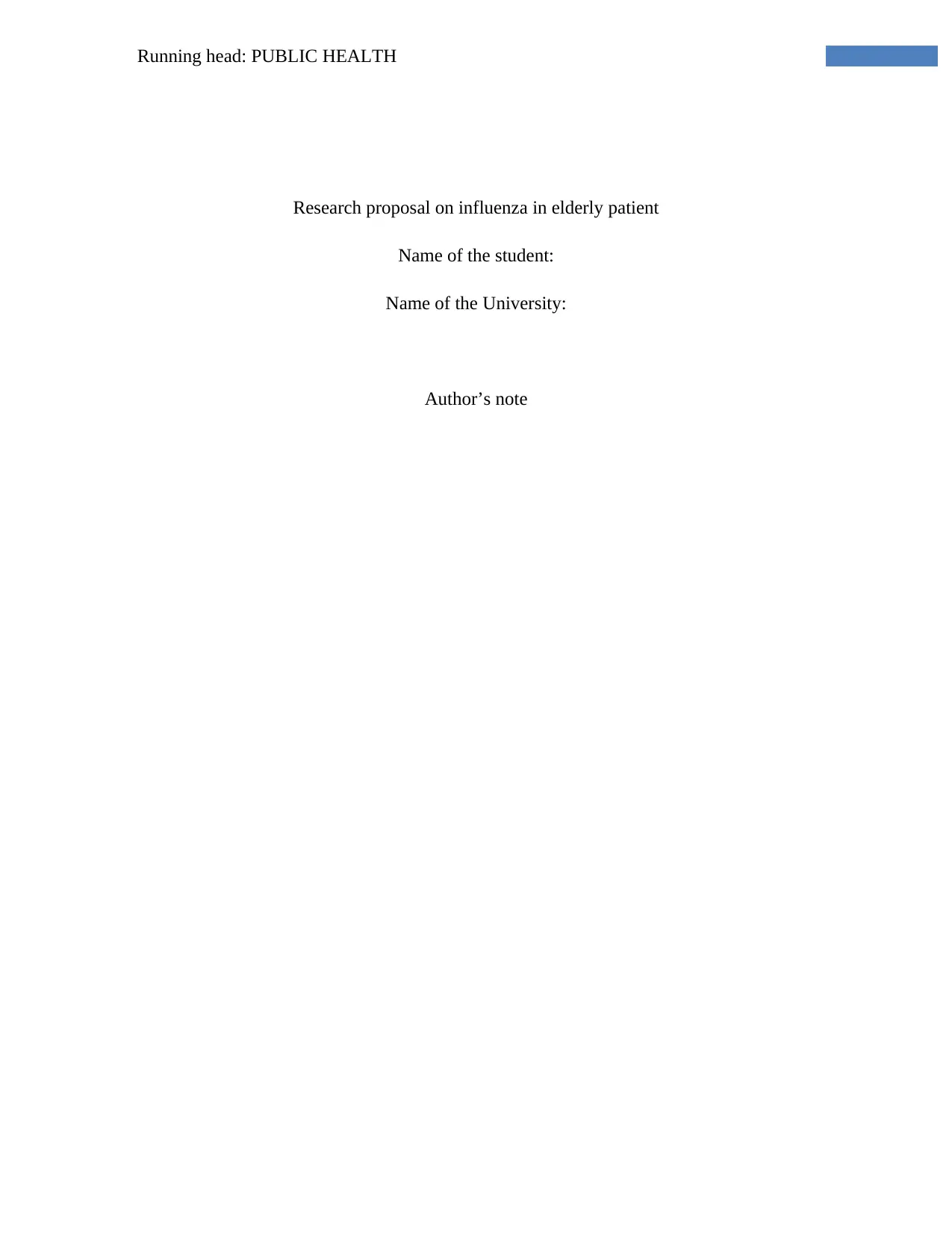
Running head: PUBLIC HEALTH
Research proposal on influenza in elderly patient
Name of the student:
Name of the University:
Author’s note
Research proposal on influenza in elderly patient
Name of the student:
Name of the University:
Author’s note
Paraphrase This Document
Need a fresh take? Get an instant paraphrase of this document with our AI Paraphraser
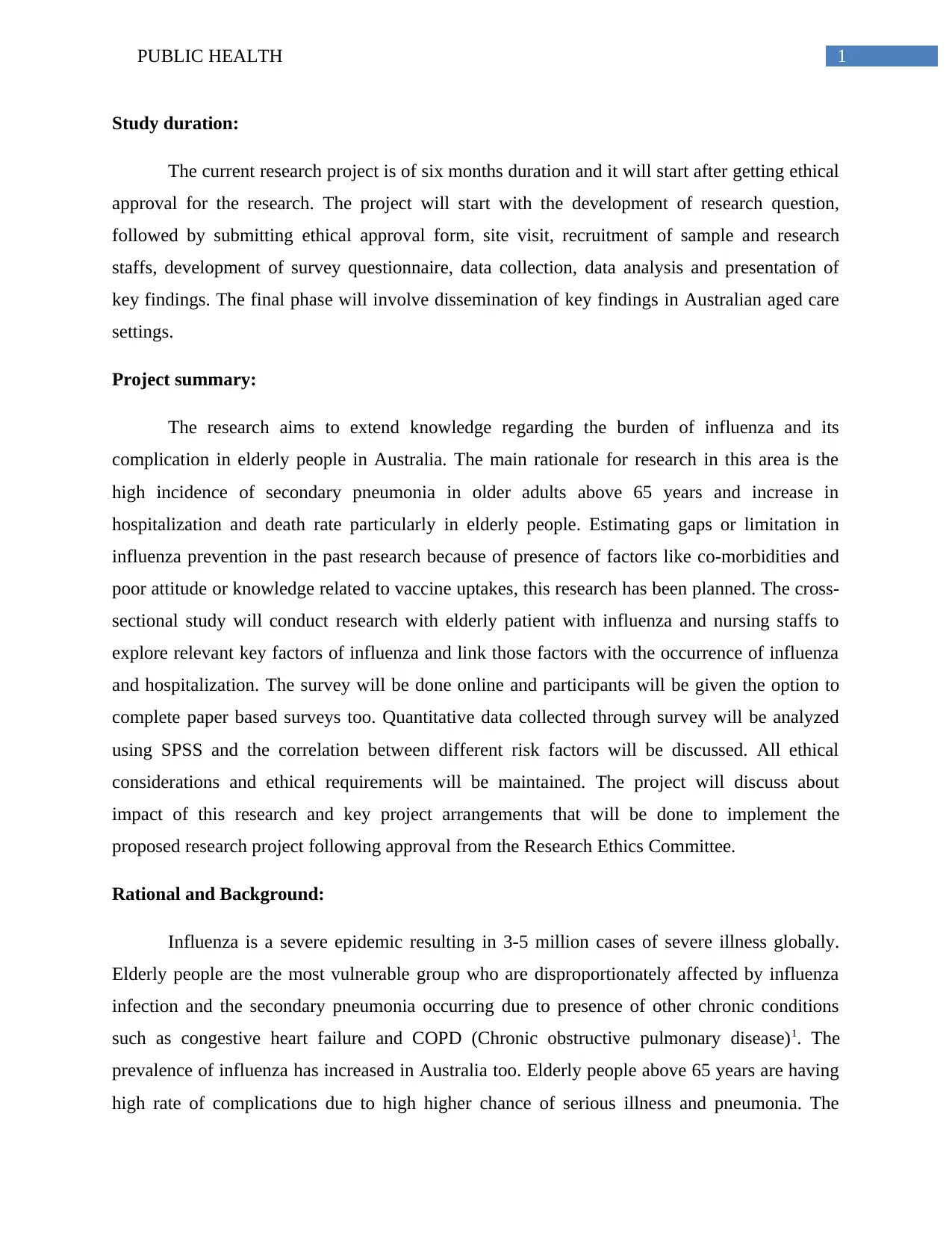
1PUBLIC HEALTH
Study duration:
The current research project is of six months duration and it will start after getting ethical
approval for the research. The project will start with the development of research question,
followed by submitting ethical approval form, site visit, recruitment of sample and research
staffs, development of survey questionnaire, data collection, data analysis and presentation of
key findings. The final phase will involve dissemination of key findings in Australian aged care
settings.
Project summary:
The research aims to extend knowledge regarding the burden of influenza and its
complication in elderly people in Australia. The main rationale for research in this area is the
high incidence of secondary pneumonia in older adults above 65 years and increase in
hospitalization and death rate particularly in elderly people. Estimating gaps or limitation in
influenza prevention in the past research because of presence of factors like co-morbidities and
poor attitude or knowledge related to vaccine uptakes, this research has been planned. The cross-
sectional study will conduct research with elderly patient with influenza and nursing staffs to
explore relevant key factors of influenza and link those factors with the occurrence of influenza
and hospitalization. The survey will be done online and participants will be given the option to
complete paper based surveys too. Quantitative data collected through survey will be analyzed
using SPSS and the correlation between different risk factors will be discussed. All ethical
considerations and ethical requirements will be maintained. The project will discuss about
impact of this research and key project arrangements that will be done to implement the
proposed research project following approval from the Research Ethics Committee.
Rational and Background:
Influenza is a severe epidemic resulting in 3-5 million cases of severe illness globally.
Elderly people are the most vulnerable group who are disproportionately affected by influenza
infection and the secondary pneumonia occurring due to presence of other chronic conditions
such as congestive heart failure and COPD (Chronic obstructive pulmonary disease)1. The
prevalence of influenza has increased in Australia too. Elderly people above 65 years are having
high rate of complications due to high higher chance of serious illness and pneumonia. The
Study duration:
The current research project is of six months duration and it will start after getting ethical
approval for the research. The project will start with the development of research question,
followed by submitting ethical approval form, site visit, recruitment of sample and research
staffs, development of survey questionnaire, data collection, data analysis and presentation of
key findings. The final phase will involve dissemination of key findings in Australian aged care
settings.
Project summary:
The research aims to extend knowledge regarding the burden of influenza and its
complication in elderly people in Australia. The main rationale for research in this area is the
high incidence of secondary pneumonia in older adults above 65 years and increase in
hospitalization and death rate particularly in elderly people. Estimating gaps or limitation in
influenza prevention in the past research because of presence of factors like co-morbidities and
poor attitude or knowledge related to vaccine uptakes, this research has been planned. The cross-
sectional study will conduct research with elderly patient with influenza and nursing staffs to
explore relevant key factors of influenza and link those factors with the occurrence of influenza
and hospitalization. The survey will be done online and participants will be given the option to
complete paper based surveys too. Quantitative data collected through survey will be analyzed
using SPSS and the correlation between different risk factors will be discussed. All ethical
considerations and ethical requirements will be maintained. The project will discuss about
impact of this research and key project arrangements that will be done to implement the
proposed research project following approval from the Research Ethics Committee.
Rational and Background:
Influenza is a severe epidemic resulting in 3-5 million cases of severe illness globally.
Elderly people are the most vulnerable group who are disproportionately affected by influenza
infection and the secondary pneumonia occurring due to presence of other chronic conditions
such as congestive heart failure and COPD (Chronic obstructive pulmonary disease)1. The
prevalence of influenza has increased in Australia too. Elderly people above 65 years are having
high rate of complications due to high higher chance of serious illness and pneumonia. The
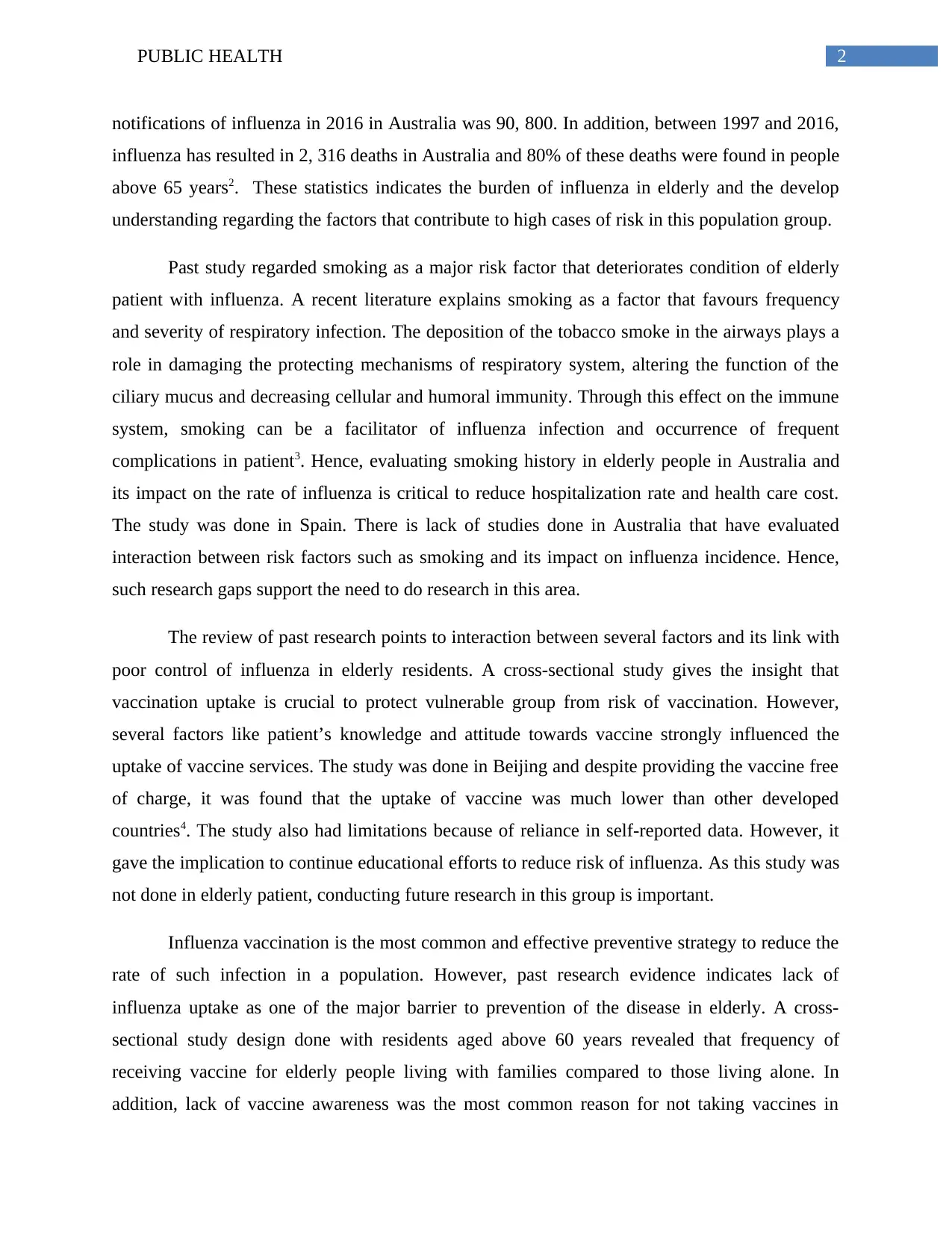
2PUBLIC HEALTH
notifications of influenza in 2016 in Australia was 90, 800. In addition, between 1997 and 2016,
influenza has resulted in 2, 316 deaths in Australia and 80% of these deaths were found in people
above 65 years2. These statistics indicates the burden of influenza in elderly and the develop
understanding regarding the factors that contribute to high cases of risk in this population group.
Past study regarded smoking as a major risk factor that deteriorates condition of elderly
patient with influenza. A recent literature explains smoking as a factor that favours frequency
and severity of respiratory infection. The deposition of the tobacco smoke in the airways plays a
role in damaging the protecting mechanisms of respiratory system, altering the function of the
ciliary mucus and decreasing cellular and humoral immunity. Through this effect on the immune
system, smoking can be a facilitator of influenza infection and occurrence of frequent
complications in patient3. Hence, evaluating smoking history in elderly people in Australia and
its impact on the rate of influenza is critical to reduce hospitalization rate and health care cost.
The study was done in Spain. There is lack of studies done in Australia that have evaluated
interaction between risk factors such as smoking and its impact on influenza incidence. Hence,
such research gaps support the need to do research in this area.
The review of past research points to interaction between several factors and its link with
poor control of influenza in elderly residents. A cross-sectional study gives the insight that
vaccination uptake is crucial to protect vulnerable group from risk of vaccination. However,
several factors like patient’s knowledge and attitude towards vaccine strongly influenced the
uptake of vaccine services. The study was done in Beijing and despite providing the vaccine free
of charge, it was found that the uptake of vaccine was much lower than other developed
countries4. The study also had limitations because of reliance in self-reported data. However, it
gave the implication to continue educational efforts to reduce risk of influenza. As this study was
not done in elderly patient, conducting future research in this group is important.
Influenza vaccination is the most common and effective preventive strategy to reduce the
rate of such infection in a population. However, past research evidence indicates lack of
influenza uptake as one of the major barrier to prevention of the disease in elderly. A cross-
sectional study design done with residents aged above 60 years revealed that frequency of
receiving vaccine for elderly people living with families compared to those living alone. In
addition, lack of vaccine awareness was the most common reason for not taking vaccines in
notifications of influenza in 2016 in Australia was 90, 800. In addition, between 1997 and 2016,
influenza has resulted in 2, 316 deaths in Australia and 80% of these deaths were found in people
above 65 years2. These statistics indicates the burden of influenza in elderly and the develop
understanding regarding the factors that contribute to high cases of risk in this population group.
Past study regarded smoking as a major risk factor that deteriorates condition of elderly
patient with influenza. A recent literature explains smoking as a factor that favours frequency
and severity of respiratory infection. The deposition of the tobacco smoke in the airways plays a
role in damaging the protecting mechanisms of respiratory system, altering the function of the
ciliary mucus and decreasing cellular and humoral immunity. Through this effect on the immune
system, smoking can be a facilitator of influenza infection and occurrence of frequent
complications in patient3. Hence, evaluating smoking history in elderly people in Australia and
its impact on the rate of influenza is critical to reduce hospitalization rate and health care cost.
The study was done in Spain. There is lack of studies done in Australia that have evaluated
interaction between risk factors such as smoking and its impact on influenza incidence. Hence,
such research gaps support the need to do research in this area.
The review of past research points to interaction between several factors and its link with
poor control of influenza in elderly residents. A cross-sectional study gives the insight that
vaccination uptake is crucial to protect vulnerable group from risk of vaccination. However,
several factors like patient’s knowledge and attitude towards vaccine strongly influenced the
uptake of vaccine services. The study was done in Beijing and despite providing the vaccine free
of charge, it was found that the uptake of vaccine was much lower than other developed
countries4. The study also had limitations because of reliance in self-reported data. However, it
gave the implication to continue educational efforts to reduce risk of influenza. As this study was
not done in elderly patient, conducting future research in this group is important.
Influenza vaccination is the most common and effective preventive strategy to reduce the
rate of such infection in a population. However, past research evidence indicates lack of
influenza uptake as one of the major barrier to prevention of the disease in elderly. A cross-
sectional study design done with residents aged above 60 years revealed that frequency of
receiving vaccine for elderly people living with families compared to those living alone. In
addition, lack of vaccine awareness was the most common reason for not taking vaccines in
⊘ This is a preview!⊘
Do you want full access?
Subscribe today to unlock all pages.

Trusted by 1+ million students worldwide
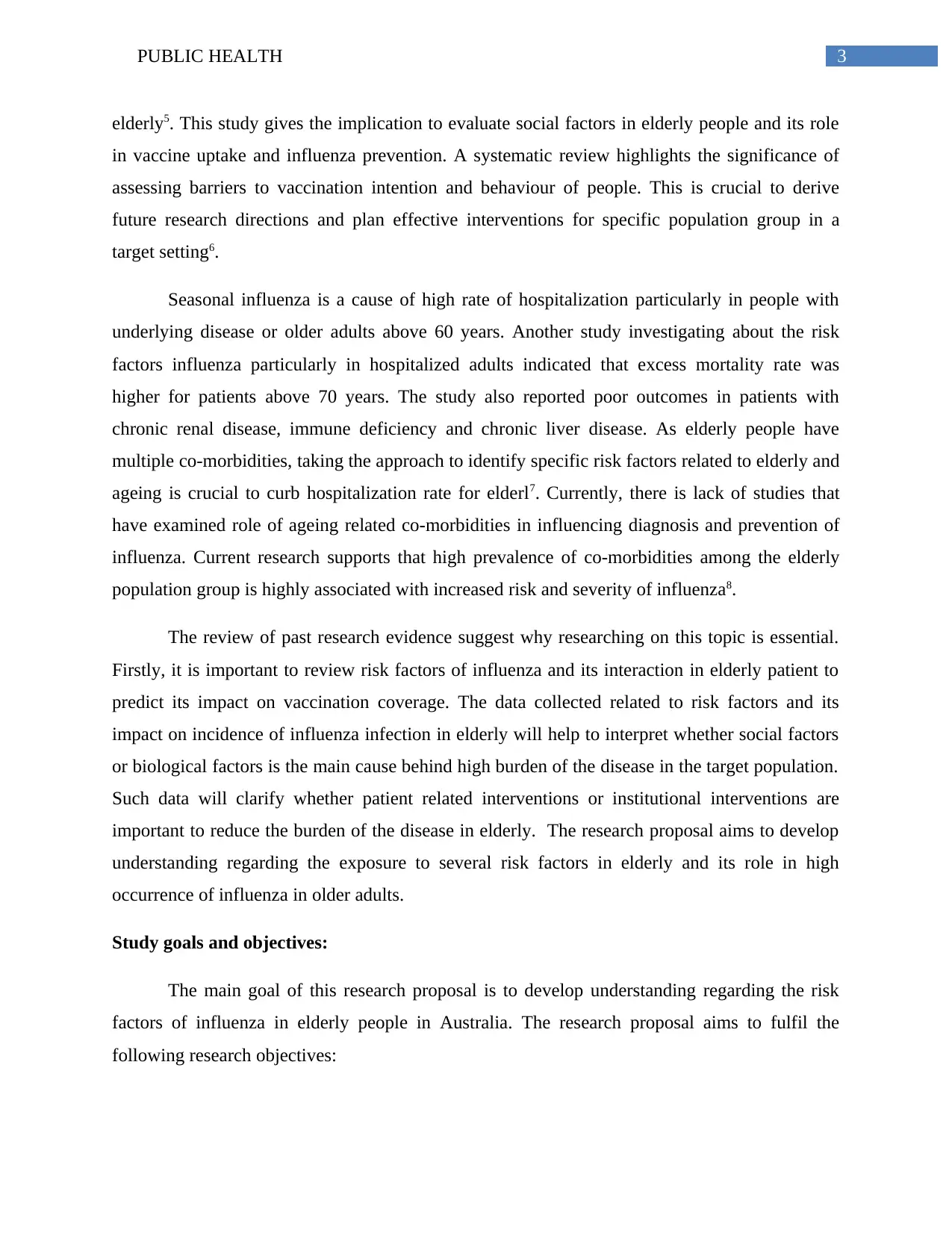
3PUBLIC HEALTH
elderly5. This study gives the implication to evaluate social factors in elderly people and its role
in vaccine uptake and influenza prevention. A systematic review highlights the significance of
assessing barriers to vaccination intention and behaviour of people. This is crucial to derive
future research directions and plan effective interventions for specific population group in a
target setting6.
Seasonal influenza is a cause of high rate of hospitalization particularly in people with
underlying disease or older adults above 60 years. Another study investigating about the risk
factors influenza particularly in hospitalized adults indicated that excess mortality rate was
higher for patients above 70 years. The study also reported poor outcomes in patients with
chronic renal disease, immune deficiency and chronic liver disease. As elderly people have
multiple co-morbidities, taking the approach to identify specific risk factors related to elderly and
ageing is crucial to curb hospitalization rate for elderl7. Currently, there is lack of studies that
have examined role of ageing related co-morbidities in influencing diagnosis and prevention of
influenza. Current research supports that high prevalence of co-morbidities among the elderly
population group is highly associated with increased risk and severity of influenza8.
The review of past research evidence suggest why researching on this topic is essential.
Firstly, it is important to review risk factors of influenza and its interaction in elderly patient to
predict its impact on vaccination coverage. The data collected related to risk factors and its
impact on incidence of influenza infection in elderly will help to interpret whether social factors
or biological factors is the main cause behind high burden of the disease in the target population.
Such data will clarify whether patient related interventions or institutional interventions are
important to reduce the burden of the disease in elderly. The research proposal aims to develop
understanding regarding the exposure to several risk factors in elderly and its role in high
occurrence of influenza in older adults.
Study goals and objectives:
The main goal of this research proposal is to develop understanding regarding the risk
factors of influenza in elderly people in Australia. The research proposal aims to fulfil the
following research objectives:
elderly5. This study gives the implication to evaluate social factors in elderly people and its role
in vaccine uptake and influenza prevention. A systematic review highlights the significance of
assessing barriers to vaccination intention and behaviour of people. This is crucial to derive
future research directions and plan effective interventions for specific population group in a
target setting6.
Seasonal influenza is a cause of high rate of hospitalization particularly in people with
underlying disease or older adults above 60 years. Another study investigating about the risk
factors influenza particularly in hospitalized adults indicated that excess mortality rate was
higher for patients above 70 years. The study also reported poor outcomes in patients with
chronic renal disease, immune deficiency and chronic liver disease. As elderly people have
multiple co-morbidities, taking the approach to identify specific risk factors related to elderly and
ageing is crucial to curb hospitalization rate for elderl7. Currently, there is lack of studies that
have examined role of ageing related co-morbidities in influencing diagnosis and prevention of
influenza. Current research supports that high prevalence of co-morbidities among the elderly
population group is highly associated with increased risk and severity of influenza8.
The review of past research evidence suggest why researching on this topic is essential.
Firstly, it is important to review risk factors of influenza and its interaction in elderly patient to
predict its impact on vaccination coverage. The data collected related to risk factors and its
impact on incidence of influenza infection in elderly will help to interpret whether social factors
or biological factors is the main cause behind high burden of the disease in the target population.
Such data will clarify whether patient related interventions or institutional interventions are
important to reduce the burden of the disease in elderly. The research proposal aims to develop
understanding regarding the exposure to several risk factors in elderly and its role in high
occurrence of influenza in older adults.
Study goals and objectives:
The main goal of this research proposal is to develop understanding regarding the risk
factors of influenza in elderly people in Australia. The research proposal aims to fulfil the
following research objectives:
Paraphrase This Document
Need a fresh take? Get an instant paraphrase of this document with our AI Paraphraser
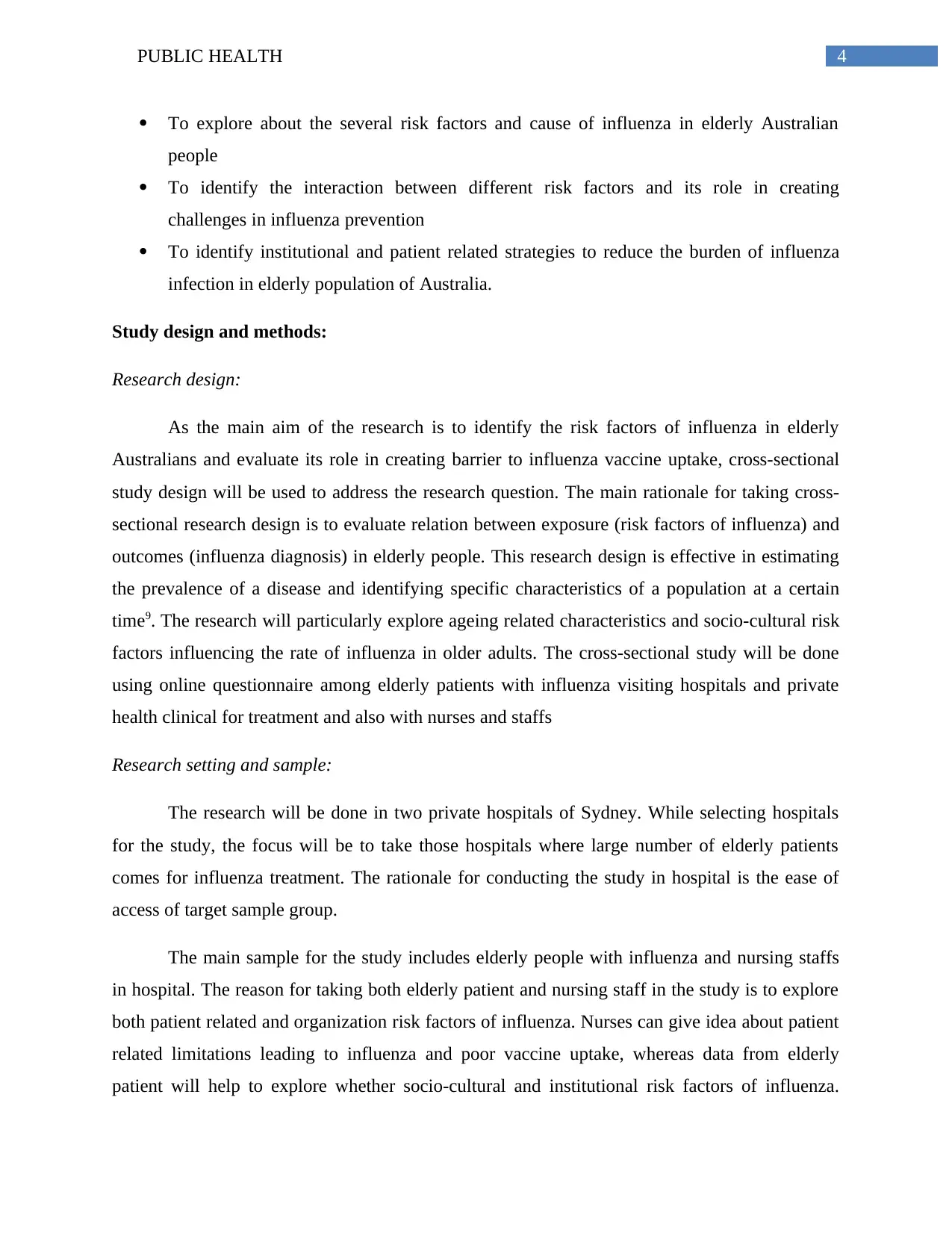
4PUBLIC HEALTH
To explore about the several risk factors and cause of influenza in elderly Australian
people
To identify the interaction between different risk factors and its role in creating
challenges in influenza prevention
To identify institutional and patient related strategies to reduce the burden of influenza
infection in elderly population of Australia.
Study design and methods:
Research design:
As the main aim of the research is to identify the risk factors of influenza in elderly
Australians and evaluate its role in creating barrier to influenza vaccine uptake, cross-sectional
study design will be used to address the research question. The main rationale for taking cross-
sectional research design is to evaluate relation between exposure (risk factors of influenza) and
outcomes (influenza diagnosis) in elderly people. This research design is effective in estimating
the prevalence of a disease and identifying specific characteristics of a population at a certain
time9. The research will particularly explore ageing related characteristics and socio-cultural risk
factors influencing the rate of influenza in older adults. The cross-sectional study will be done
using online questionnaire among elderly patients with influenza visiting hospitals and private
health clinical for treatment and also with nurses and staffs
Research setting and sample:
The research will be done in two private hospitals of Sydney. While selecting hospitals
for the study, the focus will be to take those hospitals where large number of elderly patients
comes for influenza treatment. The rationale for conducting the study in hospital is the ease of
access of target sample group.
The main sample for the study includes elderly people with influenza and nursing staffs
in hospital. The reason for taking both elderly patient and nursing staff in the study is to explore
both patient related and organization risk factors of influenza. Nurses can give idea about patient
related limitations leading to influenza and poor vaccine uptake, whereas data from elderly
patient will help to explore whether socio-cultural and institutional risk factors of influenza.
To explore about the several risk factors and cause of influenza in elderly Australian
people
To identify the interaction between different risk factors and its role in creating
challenges in influenza prevention
To identify institutional and patient related strategies to reduce the burden of influenza
infection in elderly population of Australia.
Study design and methods:
Research design:
As the main aim of the research is to identify the risk factors of influenza in elderly
Australians and evaluate its role in creating barrier to influenza vaccine uptake, cross-sectional
study design will be used to address the research question. The main rationale for taking cross-
sectional research design is to evaluate relation between exposure (risk factors of influenza) and
outcomes (influenza diagnosis) in elderly people. This research design is effective in estimating
the prevalence of a disease and identifying specific characteristics of a population at a certain
time9. The research will particularly explore ageing related characteristics and socio-cultural risk
factors influencing the rate of influenza in older adults. The cross-sectional study will be done
using online questionnaire among elderly patients with influenza visiting hospitals and private
health clinical for treatment and also with nurses and staffs
Research setting and sample:
The research will be done in two private hospitals of Sydney. While selecting hospitals
for the study, the focus will be to take those hospitals where large number of elderly patients
comes for influenza treatment. The rationale for conducting the study in hospital is the ease of
access of target sample group.
The main sample for the study includes elderly people with influenza and nursing staffs
in hospital. The reason for taking both elderly patient and nursing staff in the study is to explore
both patient related and organization risk factors of influenza. Nurses can give idea about patient
related limitations leading to influenza and poor vaccine uptake, whereas data from elderly
patient will help to explore whether socio-cultural and institutional risk factors of influenza.
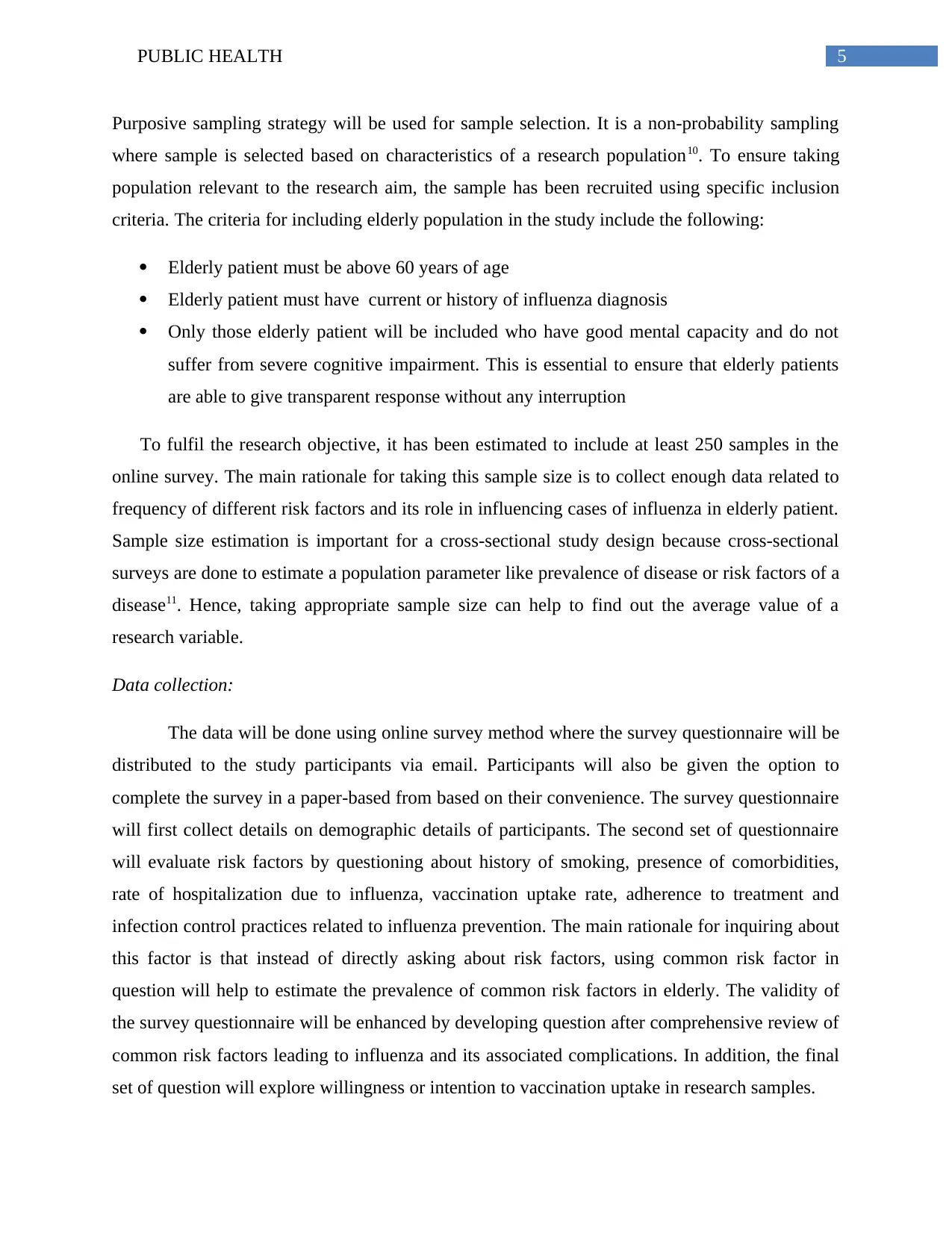
5PUBLIC HEALTH
Purposive sampling strategy will be used for sample selection. It is a non-probability sampling
where sample is selected based on characteristics of a research population10. To ensure taking
population relevant to the research aim, the sample has been recruited using specific inclusion
criteria. The criteria for including elderly population in the study include the following:
Elderly patient must be above 60 years of age
Elderly patient must have current or history of influenza diagnosis
Only those elderly patient will be included who have good mental capacity and do not
suffer from severe cognitive impairment. This is essential to ensure that elderly patients
are able to give transparent response without any interruption
To fulfil the research objective, it has been estimated to include at least 250 samples in the
online survey. The main rationale for taking this sample size is to collect enough data related to
frequency of different risk factors and its role in influencing cases of influenza in elderly patient.
Sample size estimation is important for a cross-sectional study design because cross-sectional
surveys are done to estimate a population parameter like prevalence of disease or risk factors of a
disease11. Hence, taking appropriate sample size can help to find out the average value of a
research variable.
Data collection:
The data will be done using online survey method where the survey questionnaire will be
distributed to the study participants via email. Participants will also be given the option to
complete the survey in a paper-based from based on their convenience. The survey questionnaire
will first collect details on demographic details of participants. The second set of questionnaire
will evaluate risk factors by questioning about history of smoking, presence of comorbidities,
rate of hospitalization due to influenza, vaccination uptake rate, adherence to treatment and
infection control practices related to influenza prevention. The main rationale for inquiring about
this factor is that instead of directly asking about risk factors, using common risk factor in
question will help to estimate the prevalence of common risk factors in elderly. The validity of
the survey questionnaire will be enhanced by developing question after comprehensive review of
common risk factors leading to influenza and its associated complications. In addition, the final
set of question will explore willingness or intention to vaccination uptake in research samples.
Purposive sampling strategy will be used for sample selection. It is a non-probability sampling
where sample is selected based on characteristics of a research population10. To ensure taking
population relevant to the research aim, the sample has been recruited using specific inclusion
criteria. The criteria for including elderly population in the study include the following:
Elderly patient must be above 60 years of age
Elderly patient must have current or history of influenza diagnosis
Only those elderly patient will be included who have good mental capacity and do not
suffer from severe cognitive impairment. This is essential to ensure that elderly patients
are able to give transparent response without any interruption
To fulfil the research objective, it has been estimated to include at least 250 samples in the
online survey. The main rationale for taking this sample size is to collect enough data related to
frequency of different risk factors and its role in influencing cases of influenza in elderly patient.
Sample size estimation is important for a cross-sectional study design because cross-sectional
surveys are done to estimate a population parameter like prevalence of disease or risk factors of a
disease11. Hence, taking appropriate sample size can help to find out the average value of a
research variable.
Data collection:
The data will be done using online survey method where the survey questionnaire will be
distributed to the study participants via email. Participants will also be given the option to
complete the survey in a paper-based from based on their convenience. The survey questionnaire
will first collect details on demographic details of participants. The second set of questionnaire
will evaluate risk factors by questioning about history of smoking, presence of comorbidities,
rate of hospitalization due to influenza, vaccination uptake rate, adherence to treatment and
infection control practices related to influenza prevention. The main rationale for inquiring about
this factor is that instead of directly asking about risk factors, using common risk factor in
question will help to estimate the prevalence of common risk factors in elderly. The validity of
the survey questionnaire will be enhanced by developing question after comprehensive review of
common risk factors leading to influenza and its associated complications. In addition, the final
set of question will explore willingness or intention to vaccination uptake in research samples.
⊘ This is a preview!⊘
Do you want full access?
Subscribe today to unlock all pages.

Trusted by 1+ million students worldwide
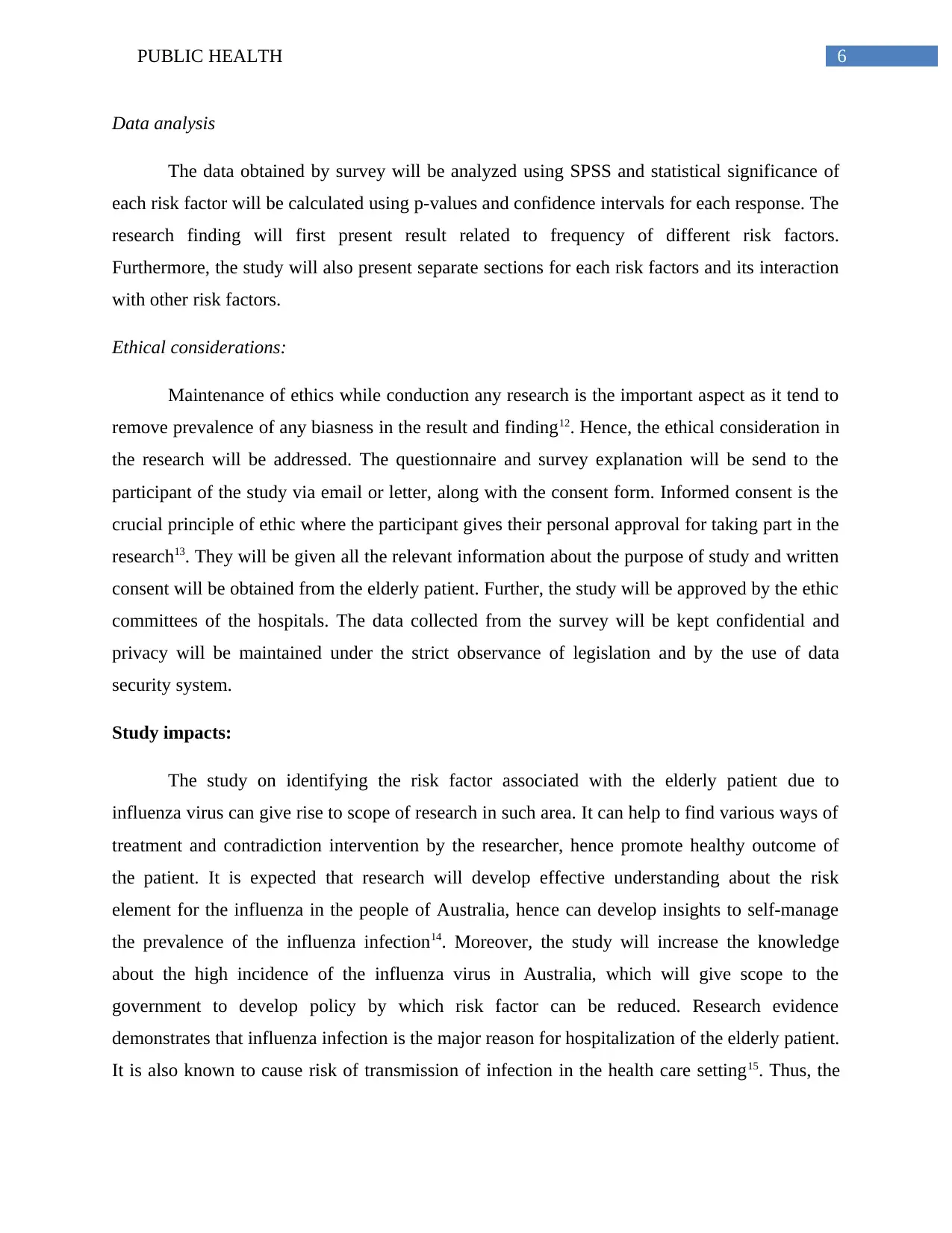
6PUBLIC HEALTH
Data analysis
The data obtained by survey will be analyzed using SPSS and statistical significance of
each risk factor will be calculated using p-values and confidence intervals for each response. The
research finding will first present result related to frequency of different risk factors.
Furthermore, the study will also present separate sections for each risk factors and its interaction
with other risk factors.
Ethical considerations:
Maintenance of ethics while conduction any research is the important aspect as it tend to
remove prevalence of any biasness in the result and finding12. Hence, the ethical consideration in
the research will be addressed. The questionnaire and survey explanation will be send to the
participant of the study via email or letter, along with the consent form. Informed consent is the
crucial principle of ethic where the participant gives their personal approval for taking part in the
research13. They will be given all the relevant information about the purpose of study and written
consent will be obtained from the elderly patient. Further, the study will be approved by the ethic
committees of the hospitals. The data collected from the survey will be kept confidential and
privacy will be maintained under the strict observance of legislation and by the use of data
security system.
Study impacts:
The study on identifying the risk factor associated with the elderly patient due to
influenza virus can give rise to scope of research in such area. It can help to find various ways of
treatment and contradiction intervention by the researcher, hence promote healthy outcome of
the patient. It is expected that research will develop effective understanding about the risk
element for the influenza in the people of Australia, hence can develop insights to self-manage
the prevalence of the influenza infection14. Moreover, the study will increase the knowledge
about the high incidence of the influenza virus in Australia, which will give scope to the
government to develop policy by which risk factor can be reduced. Research evidence
demonstrates that influenza infection is the major reason for hospitalization of the elderly patient.
It is also known to cause risk of transmission of infection in the health care setting15. Thus, the
Data analysis
The data obtained by survey will be analyzed using SPSS and statistical significance of
each risk factor will be calculated using p-values and confidence intervals for each response. The
research finding will first present result related to frequency of different risk factors.
Furthermore, the study will also present separate sections for each risk factors and its interaction
with other risk factors.
Ethical considerations:
Maintenance of ethics while conduction any research is the important aspect as it tend to
remove prevalence of any biasness in the result and finding12. Hence, the ethical consideration in
the research will be addressed. The questionnaire and survey explanation will be send to the
participant of the study via email or letter, along with the consent form. Informed consent is the
crucial principle of ethic where the participant gives their personal approval for taking part in the
research13. They will be given all the relevant information about the purpose of study and written
consent will be obtained from the elderly patient. Further, the study will be approved by the ethic
committees of the hospitals. The data collected from the survey will be kept confidential and
privacy will be maintained under the strict observance of legislation and by the use of data
security system.
Study impacts:
The study on identifying the risk factor associated with the elderly patient due to
influenza virus can give rise to scope of research in such area. It can help to find various ways of
treatment and contradiction intervention by the researcher, hence promote healthy outcome of
the patient. It is expected that research will develop effective understanding about the risk
element for the influenza in the people of Australia, hence can develop insights to self-manage
the prevalence of the influenza infection14. Moreover, the study will increase the knowledge
about the high incidence of the influenza virus in Australia, which will give scope to the
government to develop policy by which risk factor can be reduced. Research evidence
demonstrates that influenza infection is the major reason for hospitalization of the elderly patient.
It is also known to cause risk of transmission of infection in the health care setting15. Thus, the
Paraphrase This Document
Need a fresh take? Get an instant paraphrase of this document with our AI Paraphraser
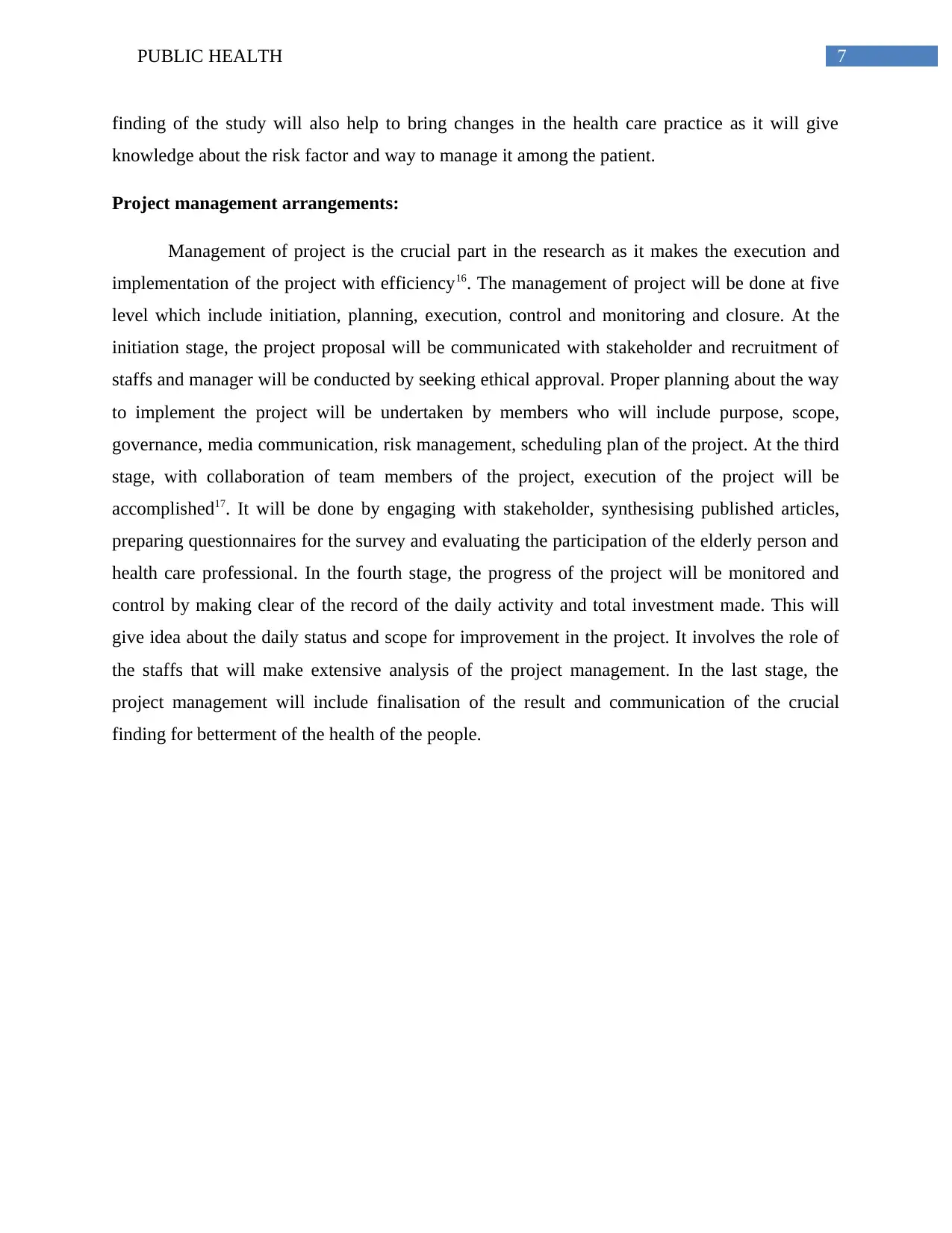
7PUBLIC HEALTH
finding of the study will also help to bring changes in the health care practice as it will give
knowledge about the risk factor and way to manage it among the patient.
Project management arrangements:
Management of project is the crucial part in the research as it makes the execution and
implementation of the project with efficiency16. The management of project will be done at five
level which include initiation, planning, execution, control and monitoring and closure. At the
initiation stage, the project proposal will be communicated with stakeholder and recruitment of
staffs and manager will be conducted by seeking ethical approval. Proper planning about the way
to implement the project will be undertaken by members who will include purpose, scope,
governance, media communication, risk management, scheduling plan of the project. At the third
stage, with collaboration of team members of the project, execution of the project will be
accomplished17. It will be done by engaging with stakeholder, synthesising published articles,
preparing questionnaires for the survey and evaluating the participation of the elderly person and
health care professional. In the fourth stage, the progress of the project will be monitored and
control by making clear of the record of the daily activity and total investment made. This will
give idea about the daily status and scope for improvement in the project. It involves the role of
the staffs that will make extensive analysis of the project management. In the last stage, the
project management will include finalisation of the result and communication of the crucial
finding for betterment of the health of the people.
finding of the study will also help to bring changes in the health care practice as it will give
knowledge about the risk factor and way to manage it among the patient.
Project management arrangements:
Management of project is the crucial part in the research as it makes the execution and
implementation of the project with efficiency16. The management of project will be done at five
level which include initiation, planning, execution, control and monitoring and closure. At the
initiation stage, the project proposal will be communicated with stakeholder and recruitment of
staffs and manager will be conducted by seeking ethical approval. Proper planning about the way
to implement the project will be undertaken by members who will include purpose, scope,
governance, media communication, risk management, scheduling plan of the project. At the third
stage, with collaboration of team members of the project, execution of the project will be
accomplished17. It will be done by engaging with stakeholder, synthesising published articles,
preparing questionnaires for the survey and evaluating the participation of the elderly person and
health care professional. In the fourth stage, the progress of the project will be monitored and
control by making clear of the record of the daily activity and total investment made. This will
give idea about the daily status and scope for improvement in the project. It involves the role of
the staffs that will make extensive analysis of the project management. In the last stage, the
project management will include finalisation of the result and communication of the crucial
finding for betterment of the health of the people.
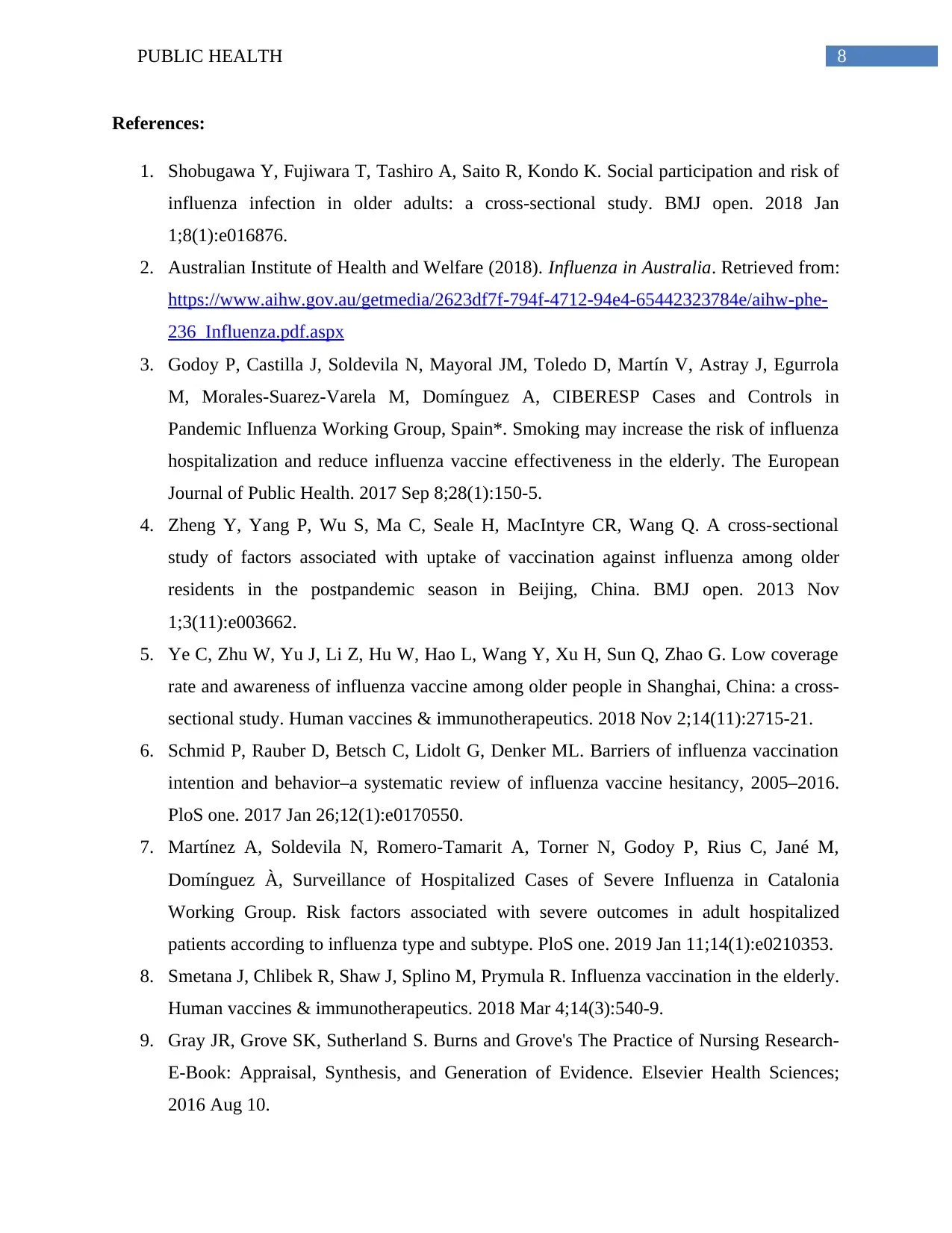
8PUBLIC HEALTH
References:
1. Shobugawa Y, Fujiwara T, Tashiro A, Saito R, Kondo K. Social participation and risk of
influenza infection in older adults: a cross-sectional study. BMJ open. 2018 Jan
1;8(1):e016876.
2. Australian Institute of Health and Welfare (2018). Influenza in Australia. Retrieved from:
https://www.aihw.gov.au/getmedia/2623df7f-794f-4712-94e4-65442323784e/aihw-phe-
236_Influenza.pdf.aspx
3. Godoy P, Castilla J, Soldevila N, Mayoral JM, Toledo D, Martín V, Astray J, Egurrola
M, Morales-Suarez-Varela M, Domínguez A, CIBERESP Cases and Controls in
Pandemic Influenza Working Group, Spain*. Smoking may increase the risk of influenza
hospitalization and reduce influenza vaccine effectiveness in the elderly. The European
Journal of Public Health. 2017 Sep 8;28(1):150-5.
4. Zheng Y, Yang P, Wu S, Ma C, Seale H, MacIntyre CR, Wang Q. A cross-sectional
study of factors associated with uptake of vaccination against influenza among older
residents in the postpandemic season in Beijing, China. BMJ open. 2013 Nov
1;3(11):e003662.
5. Ye C, Zhu W, Yu J, Li Z, Hu W, Hao L, Wang Y, Xu H, Sun Q, Zhao G. Low coverage
rate and awareness of influenza vaccine among older people in Shanghai, China: a cross-
sectional study. Human vaccines & immunotherapeutics. 2018 Nov 2;14(11):2715-21.
6. Schmid P, Rauber D, Betsch C, Lidolt G, Denker ML. Barriers of influenza vaccination
intention and behavior–a systematic review of influenza vaccine hesitancy, 2005–2016.
PloS one. 2017 Jan 26;12(1):e0170550.
7. Martínez A, Soldevila N, Romero-Tamarit A, Torner N, Godoy P, Rius C, Jané M,
Domínguez À, Surveillance of Hospitalized Cases of Severe Influenza in Catalonia
Working Group. Risk factors associated with severe outcomes in adult hospitalized
patients according to influenza type and subtype. PloS one. 2019 Jan 11;14(1):e0210353.
8. Smetana J, Chlibek R, Shaw J, Splino M, Prymula R. Influenza vaccination in the elderly.
Human vaccines & immunotherapeutics. 2018 Mar 4;14(3):540-9.
9. Gray JR, Grove SK, Sutherland S. Burns and Grove's The Practice of Nursing Research-
E-Book: Appraisal, Synthesis, and Generation of Evidence. Elsevier Health Sciences;
2016 Aug 10.
References:
1. Shobugawa Y, Fujiwara T, Tashiro A, Saito R, Kondo K. Social participation and risk of
influenza infection in older adults: a cross-sectional study. BMJ open. 2018 Jan
1;8(1):e016876.
2. Australian Institute of Health and Welfare (2018). Influenza in Australia. Retrieved from:
https://www.aihw.gov.au/getmedia/2623df7f-794f-4712-94e4-65442323784e/aihw-phe-
236_Influenza.pdf.aspx
3. Godoy P, Castilla J, Soldevila N, Mayoral JM, Toledo D, Martín V, Astray J, Egurrola
M, Morales-Suarez-Varela M, Domínguez A, CIBERESP Cases and Controls in
Pandemic Influenza Working Group, Spain*. Smoking may increase the risk of influenza
hospitalization and reduce influenza vaccine effectiveness in the elderly. The European
Journal of Public Health. 2017 Sep 8;28(1):150-5.
4. Zheng Y, Yang P, Wu S, Ma C, Seale H, MacIntyre CR, Wang Q. A cross-sectional
study of factors associated with uptake of vaccination against influenza among older
residents in the postpandemic season in Beijing, China. BMJ open. 2013 Nov
1;3(11):e003662.
5. Ye C, Zhu W, Yu J, Li Z, Hu W, Hao L, Wang Y, Xu H, Sun Q, Zhao G. Low coverage
rate and awareness of influenza vaccine among older people in Shanghai, China: a cross-
sectional study. Human vaccines & immunotherapeutics. 2018 Nov 2;14(11):2715-21.
6. Schmid P, Rauber D, Betsch C, Lidolt G, Denker ML. Barriers of influenza vaccination
intention and behavior–a systematic review of influenza vaccine hesitancy, 2005–2016.
PloS one. 2017 Jan 26;12(1):e0170550.
7. Martínez A, Soldevila N, Romero-Tamarit A, Torner N, Godoy P, Rius C, Jané M,
Domínguez À, Surveillance of Hospitalized Cases of Severe Influenza in Catalonia
Working Group. Risk factors associated with severe outcomes in adult hospitalized
patients according to influenza type and subtype. PloS one. 2019 Jan 11;14(1):e0210353.
8. Smetana J, Chlibek R, Shaw J, Splino M, Prymula R. Influenza vaccination in the elderly.
Human vaccines & immunotherapeutics. 2018 Mar 4;14(3):540-9.
9. Gray JR, Grove SK, Sutherland S. Burns and Grove's The Practice of Nursing Research-
E-Book: Appraisal, Synthesis, and Generation of Evidence. Elsevier Health Sciences;
2016 Aug 10.
⊘ This is a preview!⊘
Do you want full access?
Subscribe today to unlock all pages.

Trusted by 1+ million students worldwide
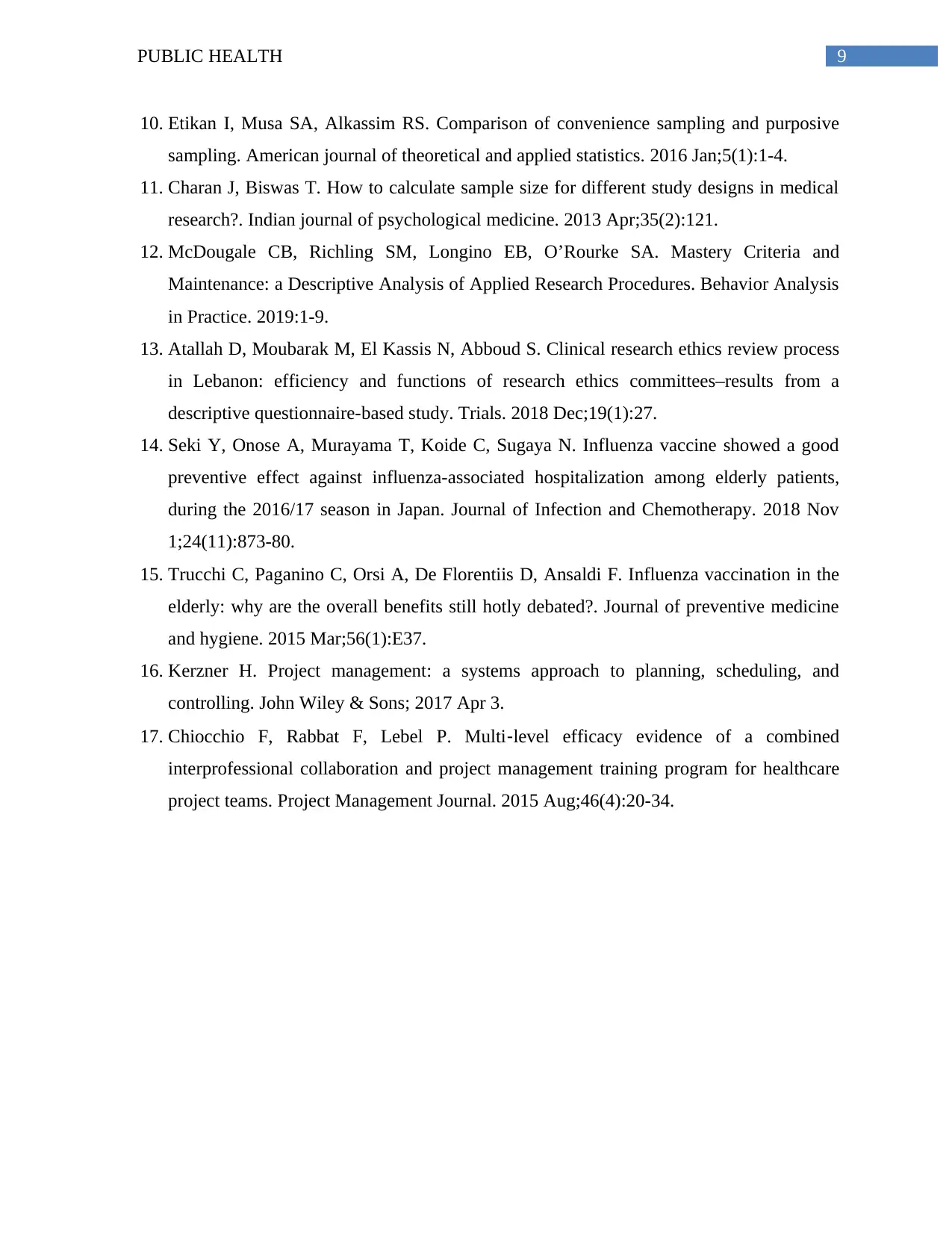
9PUBLIC HEALTH
10. Etikan I, Musa SA, Alkassim RS. Comparison of convenience sampling and purposive
sampling. American journal of theoretical and applied statistics. 2016 Jan;5(1):1-4.
11. Charan J, Biswas T. How to calculate sample size for different study designs in medical
research?. Indian journal of psychological medicine. 2013 Apr;35(2):121.
12. McDougale CB, Richling SM, Longino EB, O’Rourke SA. Mastery Criteria and
Maintenance: a Descriptive Analysis of Applied Research Procedures. Behavior Analysis
in Practice. 2019:1-9.
13. Atallah D, Moubarak M, El Kassis N, Abboud S. Clinical research ethics review process
in Lebanon: efficiency and functions of research ethics committees–results from a
descriptive questionnaire-based study. Trials. 2018 Dec;19(1):27.
14. Seki Y, Onose A, Murayama T, Koide C, Sugaya N. Influenza vaccine showed a good
preventive effect against influenza-associated hospitalization among elderly patients,
during the 2016/17 season in Japan. Journal of Infection and Chemotherapy. 2018 Nov
1;24(11):873-80.
15. Trucchi C, Paganino C, Orsi A, De Florentiis D, Ansaldi F. Influenza vaccination in the
elderly: why are the overall benefits still hotly debated?. Journal of preventive medicine
and hygiene. 2015 Mar;56(1):E37.
16. Kerzner H. Project management: a systems approach to planning, scheduling, and
controlling. John Wiley & Sons; 2017 Apr 3.
17. Chiocchio F, Rabbat F, Lebel P. Multi‐level efficacy evidence of a combined
interprofessional collaboration and project management training program for healthcare
project teams. Project Management Journal. 2015 Aug;46(4):20-34.
10. Etikan I, Musa SA, Alkassim RS. Comparison of convenience sampling and purposive
sampling. American journal of theoretical and applied statistics. 2016 Jan;5(1):1-4.
11. Charan J, Biswas T. How to calculate sample size for different study designs in medical
research?. Indian journal of psychological medicine. 2013 Apr;35(2):121.
12. McDougale CB, Richling SM, Longino EB, O’Rourke SA. Mastery Criteria and
Maintenance: a Descriptive Analysis of Applied Research Procedures. Behavior Analysis
in Practice. 2019:1-9.
13. Atallah D, Moubarak M, El Kassis N, Abboud S. Clinical research ethics review process
in Lebanon: efficiency and functions of research ethics committees–results from a
descriptive questionnaire-based study. Trials. 2018 Dec;19(1):27.
14. Seki Y, Onose A, Murayama T, Koide C, Sugaya N. Influenza vaccine showed a good
preventive effect against influenza-associated hospitalization among elderly patients,
during the 2016/17 season in Japan. Journal of Infection and Chemotherapy. 2018 Nov
1;24(11):873-80.
15. Trucchi C, Paganino C, Orsi A, De Florentiis D, Ansaldi F. Influenza vaccination in the
elderly: why are the overall benefits still hotly debated?. Journal of preventive medicine
and hygiene. 2015 Mar;56(1):E37.
16. Kerzner H. Project management: a systems approach to planning, scheduling, and
controlling. John Wiley & Sons; 2017 Apr 3.
17. Chiocchio F, Rabbat F, Lebel P. Multi‐level efficacy evidence of a combined
interprofessional collaboration and project management training program for healthcare
project teams. Project Management Journal. 2015 Aug;46(4):20-34.
1 out of 10
Related Documents
Your All-in-One AI-Powered Toolkit for Academic Success.
+13062052269
info@desklib.com
Available 24*7 on WhatsApp / Email
![[object Object]](/_next/static/media/star-bottom.7253800d.svg)
Unlock your academic potential
Copyright © 2020–2025 A2Z Services. All Rights Reserved. Developed and managed by ZUCOL.





